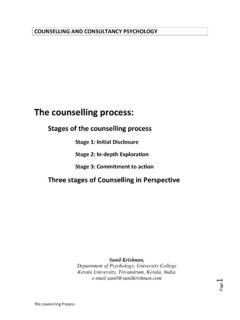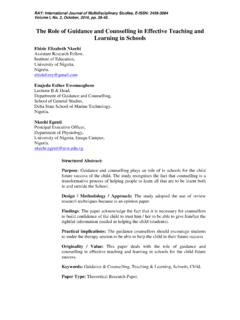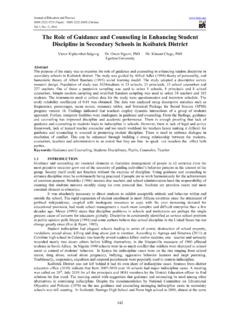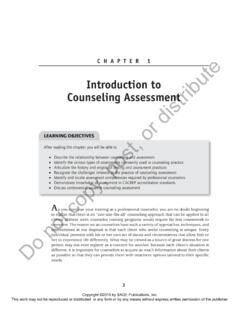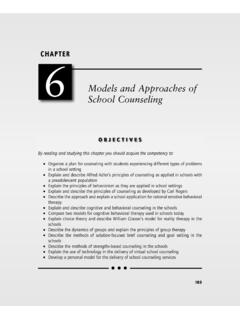Transcription of AN INTRODUCTION TO PERSON-CENTRED COUNSELLING …
1 1 AN INTRODUCTION TO PERSON-CENTRED COUNSELLING PSYCHOLOGY Professor EWAN GILLON CHAPTER 3 A PERSON-CENTRED THEORY OF PSYCHOLOGICAL THERAPY 2 INTRODUCTION As we saw in the previous chapter, Rogers (1959) theory of personality posited incongruence between organismic experiencing and the self-concept as the sole cause of all psychological disturbance. Following on from such a view, it is the reduction of incongruence that is associated with greater psychological wellbeing and, as such, provides the rationale for a PERSON-CENTRED approach to psychological therapy. In this chapter we shall explore the PERSON-CENTRED therapeutic approach, highlighting how it works to reduce incongruence in the ways initially described by Rogers (1957), as well as those subsequently developed by others within the framework ( experiential practitioners) A theory of therapy Since first outlining his ideas for psychotherapy in the early 1940s, Carl Rogers consistently highlighted the role of the relationship between client and counsellor as of primary significance in therapeutic practice.
2 This was a stance that evolved from his own experiences of working as a psychologist, and informed by his awareness of a wide range of other psychological theories and approaches. Rogers saw an effective therapeutic relationship as denoted by the presence of a systematic series of counsellor attitudes in conjunction with certain factors primarily linked to the client. If each of these dimensions were in place, he argued it was inevitable that psychological growth would occur. In 1957 he published a paper entitled The Necessary and Sufficient Conditions of Therapeutic Personality Change in which he detailed six conditions which were necessary and sufficient for psychological change to occur within a client. Rogers deliberately used the word sufficient to make it absolutely clear that these conditions, if met, were enough to produce change. Nothing else was needed. Indeed, he saw further techniques or methods drawing on the expertise of the therapist (such as advice-giving or interpretations) as an irrelevant sideshow.
3 This paper is now known as his integrative statement (Wilkins, 2003) because it was designed to be relevant to all psychotherapy and drew on research and analysis from a 3 range of psychological approaches, not simply PERSON-CENTRED therapy. Hence, Rogers (1957) proposition was that any relationship possessing the conditions he specified would produce psychological change within the client, irrespective of whichever psychological approach was employed. For him, psychoanalytic and behaviourist approaches would thus be equally effective if the relationship between client and therapist in these contexts possessed the same qualities, and in the same measures, as those offered within a PERSON-CENTRED therapeutic context. What really mattered was the relationship a therapist had with his or her client, with psychological change guaranteed if this relationship met the following conditions (Rogers, 1957): 1. Two persons are in psychological contact.
4 2. The first, whom we shall term the client, is in a state of incongruence, being vulnerable or anxious. 3. The second person, whom we shall term the therapist, is congruent or integrated in the relationship. 4. The therapist experiences unconditional positive regard for the client. 5. The therapist experiences an empathic understanding of the client s internal frame of reference and endeavours to communicate this experience to the client. 6. The communication to the client of the therapists empathic understanding and unconditional positive regard is to a minimal degree achieved. Although there is some discussion over the precise terminology of the conditions as stated ( Embleton-Tudor et al. 2005), the emphasis on relationship is clear. In general, the 6 conditions are considered as to have two basic components, those associated with the actions and experiences of the therapist (conditions 3, 4 and 5), and those linked to the client s experiences and capacity to engage in a therapeutic relationship.
5 Conditions 3, 4 and 5, the so-called therapist conditions (Barratt-Lennard, 1998) are often termed the core conditions, and are those most often referred to within other therapeutic orientations ( Egan, 1998) as well as providing the focus for much research and analysis ( Norcross, 2002). They are seen as core because they concern the conduct the therapy itself and are thus often seen as the vehicle through which change is enabled. Each is seen to play a different, but equally important, part in facilitating a client to become more congruent. 4 The core conditions The three core conditions, empathy, unconditional positive regard and congruence, present a considerable challenge to the PERSON-CENTRED practitioner, for they are not formulated as skills to be acquired, but rather as personal attitudes or attributes experienced by the therapist, as well as communicated to the client for therapy to be successful (this latter requirement is stated in condition 6).
6 Congruence (condition 3) is somewhat different but again seen as a quality of the therapist, rather than an action or skill. This emphasis on personal attributes served to counteract any existing notions that PERSON-CENTRED therapy is simply a mechanistic process of non-directive repetition in the presence of warmth (as often simplistically understood). However, in placing the emphasis upon the therapist to experience particular qualities, and to communicate these in such a way that is, at the very least, minimally achieved (condition 6), Rogers highlighted the very personal nature of the therapeutic relationship he envisaged. For Rogers, therapeutic work is an inherently personal task with its success wholly dependent on the capacity of the therapist to enter into an experiential relationship with a client, not hide behind professional masks or intellectual expertise. This capacity is not acquired through formalised academic learning or by training to be a professional psychologist (although such knowledge is important to support such work), but through self-development and personal growth activities, such as group and personal therapy.
7 Indeed, he later described this capacity, once developed, as a way of being (Rogers, 1980), suggesting at times that the very presence of another person offering these qualities is sufficient for psychological change to occur (Rogers, 1986). Box. 1 Non-Directivity and the Therapeutic Relationship Although often not stated directly, the principle of non-directivity is often seen to remains at the heart of Rogers PERSON-CENTRED approach to therapy ( Grant, 1990). It is enmeshed in the 6 conditions identified by Rogers in 1957, and in particular the conditions of therapist empathy and unconditional positive regard. In being committed to offering these attitudes, a PERSON-CENTRED counsellor does not attempt to take control of a client s experiencing by diagnosing particular psychological disorders or by instructing a client how best to deal with the problems he or she encounters. Instead, the client is viewed as the expert on his or her own life, and accordingly supported to exercise autonomy in making choices (Merry, 1999), As a result of this non-directive approach, the client is enabled to grow in accordance with his or her unique attributes, and fully 5 trusted in this process.
8 A commitment to non-directivity represents, at its most basic, a fundamental PERSON-CENTRED belief in the client s actualising tendency, or in other words her capacity to function as an autonomous, constructive and self-regarding being. The notion of non-directivity is a highly controversial aspect of PERSON-CENTRED theory, with critics such as Kahn, (1999) arguing that it renders a therapist passive in the face of all client desires or intents, as well as denying the inevitable impact of the counsellors own views and ideas on the COUNSELLING process itself. However, Mearns and Thorne (2000) propose that the whole question over non-directivity is misplaced, for like in the 1940 s, the idea is often misinterpreted as a behaviour rather than an attitude or principle. Instead it is better seen, as Merry (1999) suggests as a general non-authoritarian refers also to the theory that the actualising tendency can be fostered in a relationship of particular qualities, and that whilst the general direction of that tendency is regarded as constructive and creative, its particular characteristics in any one person cannot be predicted, and should not be controlled or directed ( ).
9 Empathy Empathy is perhaps the most well-known of Rogers therapeutic conditions, and is certainly the one which attracted the most attention at the early stages of the approach (Raskin, 1948: Patterson, 2000). The key characteristic of empathy is understanding another persons subjective reality as she experiences it at any given moment. This requires an orientation toward the clients frame of reference , a phenomenological term used to describe the particular issues, concerns and values that are relevant to that individual in that moment. It is thus an attitude through which the therapist strives to enter the client s private perceptual world and [become] thoroughly at home within in (Rogers, 1980, p142). In other words, empathy is the experience of trying to fully understand another person s world. In contrast to sympathy, which involves a sharing of outlook or experience, empathy requires a bracketing (Cooper, 2004) or setting aside, by the practitioner, of own experiences, attitudes and ideas, with a focus, instead, on trying to understand how another person is feeling and thinking.
10 From a therapists point of view, an empathic attitude is a desire to understand a clients perceptual world as if it was his or her own (Rogers, 1959). The term as if is important here, for it denotes that empathy is about deeply understanding a client s experiences while at the same time not forgetting that they reside within the client (Macmillan, 1997). This recognition allows a counsellor to maintain the separation between his or her own experiences and those of another 6 (Tolan, 2003), something which is of paramount importance to avoid confusion and misunderstanding. Being empathic The most common method of experiencing empathy is to listen to closely to what a client is saying, not only though words, but also through all forms of non-verbal and bodily communication. For Brodley (2000, ) the targets of empathic understanding are thus a clients perceptions, reactions, and feelings, and the ways in which the client as a self or person is an agency, an actor, and active force a source of actions and reactions.

